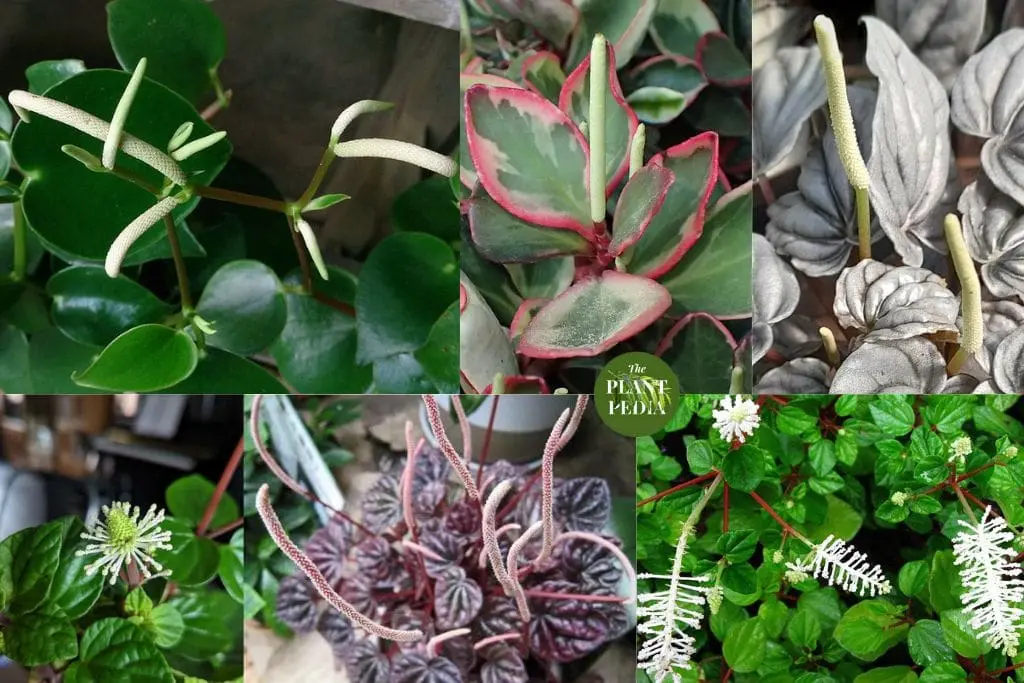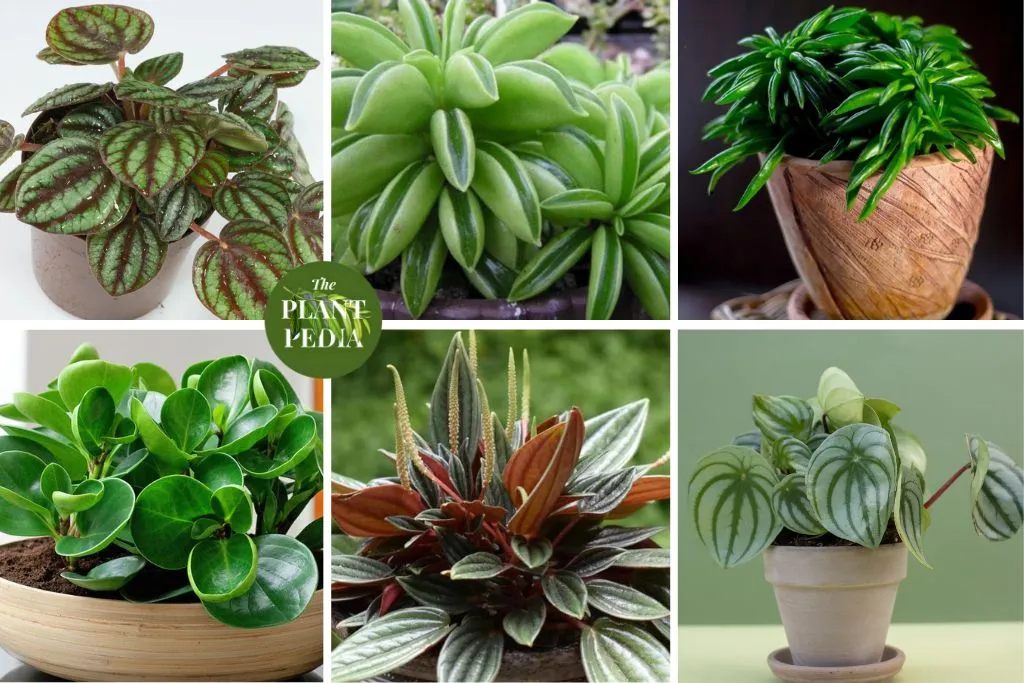In the realm of indoor gardening and houseplant enthusiasts, one often encounters the elegant and diverse world of peperomia plants.
Renowned for their captivating foliage, these plants also surprise and delight with their unique and intricate flowers and flower spikes.
The Peperomia genus, part of the Piperaceae family, boasts over 1,000 species, each with its own distinctive characteristics.
In this blog post, we will delve into the enchanting world of peperomia flowers and explore the fascinating phenomenon of peperomia flower spikes.
Peperomia Flowers: An Overview
Peperomia flowers are bisexual, which means that they have both male and female reproductive organs. This is unusual for a plant family, as most members of the Piperaceae family have unisexual flowers.
However, there are a few other genera in the family that also have bisexual flowers, such as Peperomia and Peperomiopsis.
Bisexual flowers are more efficient at producing seeds than unisexual flowers, as they do not require two plants to be present for pollination to occur. This is likely why Peperomia has evolved to have bisexual flowers.
The flowers of Peperomia are small and inconspicuous, and they are often hidden among the leaves. They are typically green or brown in color, and they have a tubular shape.
The male parts of the flower are located at the top of the tube, and the female parts are located at the bottom.
Pollination of Peperomia flowers is usually done by insects, such as bees and flies. The insects are attracted to the flowers by their sweet nectar.
When an insect visits a flower, it picks up pollen from the male parts and carries it to the female parts of another flower. This process of pollination allows the plant to reproduce and produce seeds.

Unveiling the Anatomy of Peperomia Flowers
To truly appreciate the beauty of peperomia flowers, it’s essential to understand their anatomy. As we mentioned before, peperomia flowers are bisexual, meaning they contain both male and female reproductive structures.
The flower structure includes:
- Bracts: Bracts are leaf-like structures that often surround the base of the flower. They can be colorful, adding to the visual appeal of the plant even before the flowers fully bloom.
- Sepals and Petals: Peperomia flowers typically have three to four sepals and no petals. These structures protect the inner reproductive parts of the flower.
- Stamens: The stamens are the male reproductive organs of the flower, consisting of a filament and an anther. The anther is where pollen is produced.
- Pistil: The pistil is the female reproductive organ, consisting of the stigma, style, and ovary. The stigma receives pollen, the style connects it to the ovary, and the ovary houses the ovules.
- Inflorescence: Peperomia flowers are often arranged in inflorescences, which are clusters or arrangements of multiple flowers on a single stem. This adds to the visual interest and impact of the flowers.
The Intrigue of Peperomia Flower Spikes
One of the most intriguing phenomena related to peperomia flowers is the development of flower spikes. A flower spike, also known as an inflorescence, is a cluster of flowers that grow on a single stem.
The formation of flower spikes in peperomias is not only fascinating but also serves as a vital aspect of the plant’s reproduction.
The development of a flower spike begins with the plant’s natural cues, often influenced by environmental factors such as light, temperature, and humidity.
As the plant perceives these cues, it initiates the process of flower spike formation. The timing and frequency of flower spikes can vary significantly between different species of peperomia.
Environmental Factors and Flower Spike Formation
- Light: Adequate light is crucial for peperomias to develop flower spikes. While they can tolerate lower light conditions, providing bright, indirect light can encourage more frequent flowering. Insufficient light may result in lush foliage growth but limited or no flower spike formation.
- Temperature: Temperature fluctuations can play a role in the initiation of flower spikes. Many peperomias thrive in temperatures ranging from 65°F to 75°F (18°C to 24°C). Slight temperature drops at night can mimic the natural conditions that trigger flowering in their native habitats.
- Humidity: Higher humidity levels can positively impact peperomia flower spike development. In drier indoor environments, misting the plants or placing a humidity tray nearby can create the ideal conditions for flowering.
Caring for Peperomias to Encourage Flowering
To enjoy the sight of delicate peperomia flower spikes, it’s essential to provide the right care:
- Light: As mentioned earlier, providing bright, indirect light is key. Placing your peperomias near a south or west-facing window can offer the optimal light levels.
- Watering: Peperomias prefer to dry out slightly between waterings. Overwatering can lead to root rot, so allow the top inch of soil to dry before watering again. Adjust the frequency of watering based on the specific species and the environmental conditions.
- Humidity: If you live in a dry climate, consider using a humidifier or placing a tray of water near your plants. Misting can also provide a humidity boost.
- Potting Mix: Use a well-draining potting mix to prevent waterlogged roots. A mix that includes components like perlite, orchid bark, or coconut coir can ensure proper drainage.
- Fertilization: During the growing season (spring and summer), feed your peperomias with a balanced, diluted fertilizer every 4-6 weeks. This can support healthy foliage and flower spike development.
Read: Peperomia Care (Radiator Plant): A Complete Guidelines.
Species Spotlight: Notable Peperomia Flowers and Flower Spikes
- Peperomia caperata (Emerald Ripple Peperomia): This popular species showcases heart-shaped leaves and produces slender flower spikes adorned with small, pale pink flowers. The flower spikes emerge from the center of the plant, adding an elegant touch to its appearance.
- Peperomia obtusifolia (Baby Rubber Plant): While known for its attractive foliage, P. obtusifolia occasionally surprises with delicate, cream-colored flower spikes. These spikes are relatively inconspicuous, but they add a subtle charm to the overall aesthetic of the plant.
- Peperomia clusiifolia (Red Edge Peperomia): This peperomia variety stands out with its vibrant green leaves and striking red edges. Its flower spikes, which emerge from the center of the plant, bear tiny cream-colored flowers, creating an enchanting contrast with the foliage.
- Peperomia argyreia (Watermelon Peperomia): Renowned for its resemblance to watermelon rinds, this peperomia species occasionally produces slender, greenish-white flower spikes. These spikes, though not the primary attraction, contribute to the plant’s unique allure.

Related FAQs:
What to do with peperomia flower spikes?
Flower spikes are normal for a few peperomia species. Generally, you shouldn’t do anything to interfere with their natural growth process.
However, there are a few considerations to keep in mind when it comes to peperomia flower spikes:
1. Allow Natural Growth: Let the flower spikes develop and bloom naturally. They indicate a healthy plant that is thriving in its environment.
2. Enjoy the Beauty: Appreciate the subtle beauty of peperomia flower spikes. They add a unique touch to your indoor garden.
3. Optimal Care: Provide your peperomia with adequate light, humidity, and water to extend the lifespan of the flower spikes.
4. Prune Spent Flowers: Trim off spent flowers to maintain the plant’s neat appearance. Use clean tools for pruning.
5. Respect Reproductive Cycle: Allow flowers to go through their natural process, contributing to the plant’s life cycle.
6. Consider Propagation: Experiment with collecting seeds for propagation if interested, though peperomia propagation is often more successful through other methods.
7. Document Growth: Capture the growth stages of flower spikes through photos, enhancing your gardening journey.
Remember, each peperomia flower spike is a testament to the plant’s health and vitality. Embrace their presence as they contribute to the allure of these remarkable plants.
Do all peperomia plants produce flowers and flower spikes?
Not all peperomia species produce flowers and flower spikes. While many peperomias are cultivated primarily for their attractive foliage, some species are known to occasionally produce delicate flower spikes.
The frequency and likelihood of flower spike development can vary depending on factors such as species, growing conditions, and care.
How can I encourage my peperomia to produce flower spikes?
To encourage your peperomia to produce flower spikes, provide it with optimal growing conditions.
This includes providing bright, indirect light, maintaining a consistent temperature range of around 65°F to 75°F (18°C to 24°C), and ensuring adequate humidity.
Avoid overwatering, and allow the top inch of soil to dry out before watering again. Additionally, feeding your peperomia with a balanced, diluted fertilizer during the growing season can support flower spike development.
Are peperomia flower spikes long-lasting?
Peperomia flower spikes tend to be relatively short-lived compared to the flowering periods of some other plants.
Depending on the species and growing conditions, the flower spikes can last anywhere from a few weeks to a couple of months.
However, the charm of peperomia flower spikes lies in their subtle beauty and intricate details, making them a captivating sight even during their relatively brief presence.
Can I propagate peperomia plants from their flower spikes?
Peperomia plants are typically propagated through methods such as leaf cuttings or stem cuttings rather than from their flower spikes.
While it’s possible to propagate peperomias from cuttings, the flower spikes themselves are not the primary means of propagation for these plants.
Focus on maintaining the health of the mother plant and encouraging occasional flower spikes to enjoy their unique beauty.
Should I remove peperomia flower spikes after they have finished blooming?
Removing spent flower spikes is not necessary for the health of the plant, but it can help redirect the plant’s energy towards other growth.
If the flower spikes become unsightly or begin to wilt, you can carefully trim them back to the base using clean and sterilized pruning tools.
This can also promote the growth of new leaves and potentially encourage the plant to produce more flower spikes in the future.
Are peperomia flowers fragrant?
The fragrance of peperomia flowers can vary among different species. Some peperomias have fragrant flowers, emitting subtle scents that may range from earthy to slightly spicy.
However, the fragrance is often not as strong or overpowering as that of certain other flowering plants.
If fragrance is important to you, consider researching the specific peperomia species you have to determine whether its flowers are known for their scent.
Can I grow peperomia outdoors to encourage flower spikes?
While some peperomia species can be grown outdoors in specific climates, many are more suited to indoor environments.
Outdoor growing conditions should closely mimic the plant’s natural habitat and provide protection from extreme temperatures and direct sunlight.
Even if grown outdoors, the development of flower spikes might still be influenced by the specific care and environmental conditions provided.
Are peperomia flower spikes toxic to pets?
Peperomia plants are generally considered non-toxic to pets, including cats and dogs.
However, it’s always a good practice to monitor your pets’ interactions with plants and ensure they don’t consume large amounts of any plant material.
If you suspect your pet has ingested a significant amount of peperomia, it’s recommended to consult with a veterinarian for guidance.
Read: Is Peperomia Toxic to Cats? A Comprehensive Analysis.
Can I encourage more frequent flower spike development by manipulating light and temperature?
While light and temperature play a role in flower spike development, it’s important to note that peperomias have natural growth cycles and genetic predispositions that influence their flowering patterns.
Providing optimal light, temperature, and humidity can certainly create a favorable environment for flower spike initiation, but forcing frequent flowering may not be entirely controllable.
Focus on providing consistent care and enjoy the occasional flower spikes that your peperomia produces.
Can I use peperomia flower spikes in floral arrangements?
The delicate and charming nature of peperomia flower spikes makes them an intriguing addition to floral arrangements.
However, due to their relatively short lifespan and small size, they are better suited for smaller arrangements, terrariums, or decorative displays.
Including peperomia flower spikes in arrangements can add a touch of uniqueness and a connection to the natural world.
Conclusion: Appreciating the Subtle Beauty
In the world of plants, it’s often the subtle and intricate details that truly captivate the senses. Peperomia flowers and flower spikes embody this concept perfectly.
While these plants may not boast the vibrant colors and showy blossoms of other species, they offer a unique charm that appeals to those who seek a deeper appreciation for nature’s wonders.
The journey of nurturing peperomias to encourage their occasional flowering is a rewarding endeavor that connects plant enthusiasts with the rhythms of the natural world.
So, the next time you gaze upon a peperomia plant, take a moment to appreciate the hidden beauty of its delicate flowers and the enigmatic allure of its flower spikes.
